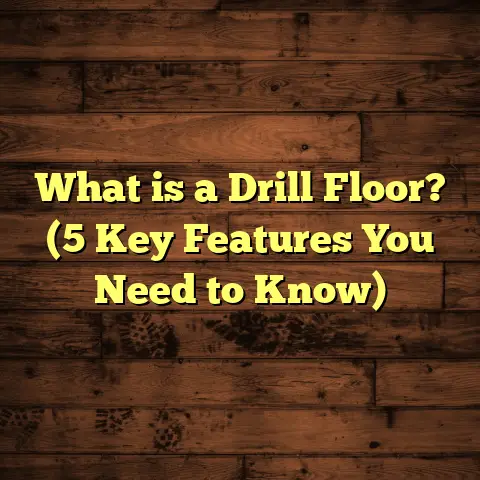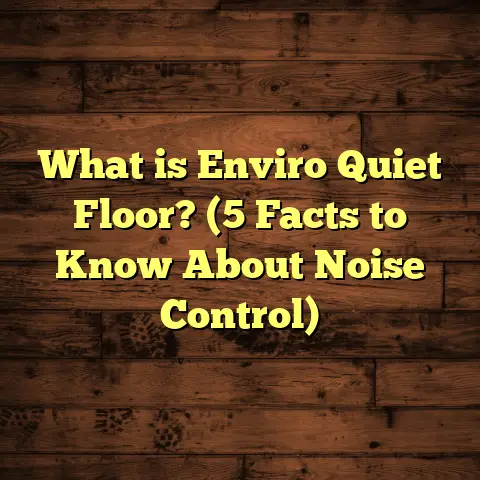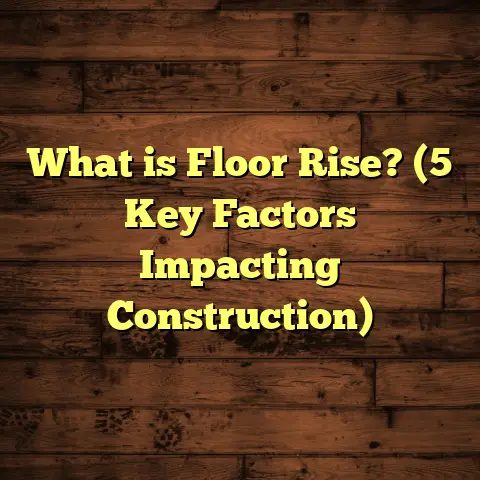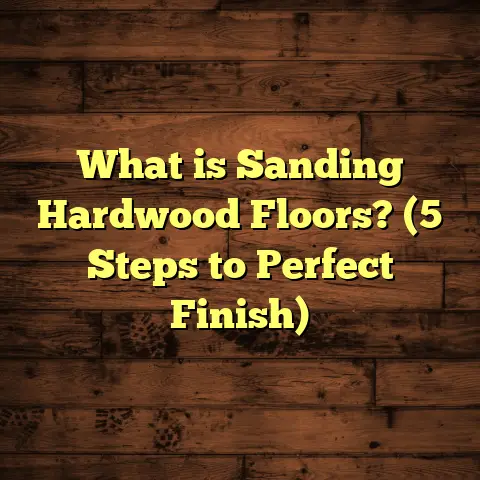What is Engineered Flooring Made Of? (5 Key Components Explained)
Have you ever wondered what exactly goes into engineered flooring? I mean, we see it everywhere — in homes, offices, and even retail spaces — but what’s it really made of? Since I’ve spent years working with different flooring materials, I’ve gotten pretty curious myself. So let’s talk about engineered flooring and break down the five key components that make it what it is.
What Is Engineered Flooring Made Of?
Engineered flooring is a clever solution designed to offer the beauty of hardwood but with added durability and flexibility. Unlike solid hardwood, which is a single piece of wood all the way through, engineered flooring is built up from layers. These layers are fused together under heat and pressure to create a stable plank that resists warping and swelling.
This layered construction is what sets engineered flooring apart. But what exactly makes up those layers? And why does it matter? Knowing these details can help you decide if engineered flooring fits your needs or if another option might work better.
Here’s a breakdown of the five key components that typically make up engineered flooring:
1. The Wear Layer (Top Veneer)
The wear layer is the thin slice of real hardwood on the very top of the plank.
I remember installing a floor in a client’s home where the top veneer was only 2mm thick. We had to be super careful during installation because thinner wear layers don’t take sanding well — they only allow for one or two refinishes before you hit the plywood underneath.
This layer is crucial because it gives engineered flooring its authentic hardwood appearance. The species of wood used here — oak, maple, hickory, you name it — determines the color, grain pattern, and texture you see.
Typical thickness ranges: 0.6mm to 6mm
Durability: Thicker veneers mean longer life and more opportunities for refinishing.
Fun fact: Some manufacturers use exotic woods like Brazilian cherry or walnut just for the veneer to create unique looks.
Why Wear Layer Thickness Matters
If you’re considering engineered flooring, asking about the wear layer thickness is one of the most important questions you can ask your supplier or contractor. A thin wear layer (under 2mm) means the floor can’t be sanded or refinished much — sometimes not at all. This might be fine for low-traffic areas or rental units where replacing the floor after some years isn’t a big deal.
On the other hand, thicker wear layers (3mm and above) can often be sanded multiple times. This extends the life of your floor by decades. I had a client who was hesitant about engineered flooring initially because they thought it wouldn’t last as long as solid wood. When I explained how a 4mm wear layer could be sanded 3-4 times over its life, they felt much more confident.
Species Choice in the Wear Layer
The wood species used in the wear layer affects aesthetics and hardness. For example:
- Oak: A classic choice with strong grain patterns and high durability. It’s one of the most common wear layers.
- Maple: Lighter color, less pronounced grain, and slightly softer than oak but still very durable.
- Hickory: Known for its strength and dramatic grain variation.
- Exotic woods: Brazilian cherry or teak offer unique colors but can be pricier.
From my experience, oak remains the safest bet for most homeowners because it’s widely available and offers great durability. Exotic species are fun if you want something unique but check on maintenance requirements since some woods are softer or more sensitive to UV light.
Surface Texture Options
The wear layer can come smooth or textured:
- Smooth finish: Polished look with visible grain.
- Wire-brushed or hand-scraped: Adds texture and hides scratches better.
- Distressed: Gives a rustic look but requires more care to avoid dirt buildup in grooves.
I’ve installed wire-brushed engineered floors in several homes where clients wanted a rustic yet modern feel. It’s a great way to hide everyday wear while maintaining hardwood’s natural beauty.
2. The Core Layers (Plywood or High-Density Fiberboard)
Beneath the wear layer, you’ll find the core layers, which make up most of the plank’s thickness. These layers provide stability and strength.
There are two main materials used here:
- Plywood: Thin sheets of wood veneer glued together in a cross-grain pattern. This cross-graining reduces expansion and contraction caused by moisture changes.
- High-Density Fiberboard (HDF): Made from compressed wood fibers mixed with resin, HDF cores are dense and provide a smooth base for the top layer.
From my experience, plywood cores tend to resist moisture better, making them ideal for areas with fluctuating humidity — like basements or kitchens. HDF cores can be very stable too but may not be as moisture-resistant.
The Science Behind Core Layers
The stability of engineered flooring largely depends on these core layers. Wood naturally expands and contracts with humidity changes — this can cause solid hardwood floors to warp or gap over time. By layering veneers crosswise (in plywood) or compressing fibers tightly (in HDF), manufacturers create planks that resist these movements.
In fact, tests show that plywood-core engineered flooring can reduce dimensional changes by up to 50% compared to solid wood under varying humidity levels.
One time, I installed plywood-core engineered flooring in a mountain cabin where humidity swings drastically between seasons. The floor held up beautifully without noticeable gaps or buckling even after two years.
Thickness and Number of Layers
Engineered flooring core thickness can vary from 6mm to 12mm or more, with multiple layers:
- Budget options may have fewer core layers (3-5 layers).
- Premium products often have 7+ layers for extra stability.
More layers mean better resistance to warping but also slightly higher cost.
Plywood vs. HDF Core — Which One Should You Pick?
- Plywood Core: Better moisture resistance, more dimensionally stable, often preferred for areas prone to moisture.
- HDF Core: Denser, smooth surface good for click-lock systems, usually less expensive but less moisture-resistant.
If you’re planning flooring for kitchens, basements, or places with fluctuating temperatures, I usually recommend plywood core engineered floors for peace of mind.
3. The Backing Layer (Balancing Layer)
This layer sits underneath the core layers and balances the plank to prevent cupping or bending over time.
Think of it like shoes: if your left shoe is thicker than your right, you’d walk unevenly. The backing layer evens out stresses in the plank.
Usually made from softwood or plywood, this layer also adds extra strength. Without it, the engineered floor would be prone to bending when walked upon.
Why You Don’t Hear About Backing Layers Much
Most people focus on the top veneer when choosing engineered floors but overlook backing layers. Yet this part plays a silent but critical role in keeping floors flat and stable.
I’ve seen situations where cheaper engineered flooring had very thin or no proper backing layer. Within months, planks started cupping or bending because the stresses from moisture or temperature weren’t balanced out properly.
Materials Used in Backing Layers
Common backing materials include:
- Softwood veneers — lightweight and flexible.
- Plywood sheets — add stiffness.
- Sometimes fiberglass or synthetic materials in specialty products for extra stability.
Manufacturers carefully match backing materials to core types and wear layers to create balanced planks that last years without deforming.
How Backing Layers Affect Installation
A balanced plank means easier installation because boards lay flat immediately without gaps or unevenness.
When I’m installing floors for clients who want floating installations (no glue/nails), I always check if the product has a good backing layer — otherwise the floor might develop issues faster.
4. Adhesives (Glue Binding Layers)
Ever wonder how all these layers hold together so tightly? That’s where adhesives come in.
Manufacturers use industrial-grade glues to bond layers firmly under heat and pressure during production.
There are several types of adhesives:
- Urea-formaldehyde: Common and cost-effective but less moisture-resistant.
- Phenol-formaldehyde: More durable and moisture-resistant.
- Polyurethane-based: Flexible and very strong.
Using the right adhesive affects not only durability but also indoor air quality — low-VOC adhesives are better for healthy living spaces.
Why Adhesives Are More Important Than You Think
I remember early on being surprised how many people overlooked adhesives when buying engineered floors. But poor bonding glue can cause delamination — where wear layer peels off core — especially in humid conditions.
A few years ago, I worked with a client who had delamination issues within 6 months after installation in their kitchen near a sink. Upon inspection, it turned out their floor used urea-formaldehyde glue which wasn’t suited for moisture exposure there.
Safety Considerations: VOCs and Indoor Air Quality
Adhesives can emit volatile organic compounds (VOCs), which affect indoor air quality. Some older adhesives contained formaldehyde at levels now regulated or banned in many countries.
I always recommend looking for products certified by organizations such as FloorScore or GREENGUARD — these ensure adhesives meet strict air quality standards.
How Adhesive Type Impacts Cost
Phenol-formaldehyde adhesives add cost but reduce risk of moisture damage. Polyurethane adhesives offer flexibility but are pricier still.
If you want floors in wet areas like bathrooms (engineered hardwood is not often recommended there anyway), adhesive choice becomes critical for longevity.
5. Surface Finish (Protective Coating)
The wear layer gets coated with a protective finish that seals and shields it from scratches, stains, and daily wear.
You’ve probably seen finishes like:
- Polyurethane (oil- or water-based): Durable and glossy.
- UV-cured finishes: Very hard and fast-drying.
- Aluminum oxide: Extremely tough finish often used on prefinished floors.
This finish also impacts how the floor looks — matte, satin, or high gloss — and how easy it is to clean.
Finishes Make a Big Difference in Durability
During my installations, I’ve noticed floors with aluminum oxide finishes stay looking newer much longer than standard polyurethane ones. Aluminum oxide creates an invisible shield that really resists scratches from pets’ claws or moving furniture.
UV-cured finishes also dry quickly at factories allowing faster production turnaround times without compromising durability.
Pros and Cons of Popular Finish Types
| Finish Type | Durability | Appearance Options | Maintenance |
|---|---|---|---|
| Oil-Based Polyurethane | Good | Warm amber tone | Requires periodic polishing |
| Water-Based Polyurethane | Moderate | Clear finish | Low odor; easy cleanup |
| UV-Cured | Excellent | Matte to high gloss | Very hard wearing |
| Aluminum Oxide | Excellent | Usually clear | Minimal maintenance |
I recently helped a family pick finishes for their new engineered floor in their busy household with kids and dogs. We chose aluminum oxide because they wanted something practically indestructible yet natural looking.
How Engineered Flooring Gets Made: Manufacturing Insights
Understanding how these components come together helps me appreciate engineering behind every plank I install:
- Veneer slicing: Logs are sliced into thin sheets (0.6mm to 6mm) for wear layers.
- Core preparation: Plywood sheets or HDF boards are cut to size.
- Layer assembly: Veneers glued crosswise into cores using hot presses.
- Sanding: Planks sanded smooth before finishing.
- Finishing: Protective coatings applied (several layers).
- Cutting & packaging: Finished floors cut into planks/tiles then boxed for shipment.
Each step is carefully controlled to maintain dimensional accuracy — which means floors fit well during installation without gaps or unevenness.
Environmental Considerations: Sustainability in Engineered Flooring
As someone who cares about eco-friendly building practices, I always look at sustainability when recommending materials:
- Using thin veneers means less precious hardwood is used per plank compared to solid wood floors.
- Many manufacturers source plywood cores from sustainably managed forests.
- Some brands use formaldehyde-free adhesives improving indoor air quality.
- Engineered floors can sometimes be recycled at end-of-life better than laminate floors due to real wood content.
According to recent industry data:
- Over 70% of engineered flooring brands now source FSC-certified wood (Forest Stewardship Council).
- Low-VOC adhesive use has increased by 30% in past five years globally.
This makes engineered flooring an attractive choice for eco-conscious homeowners wanting real wood aesthetics without sacrificing environmental responsibility.
Installation Tips Related to Engineered Flooring Components
Knowing what goes inside your floor helps guide installation choices too:
- Floors with plywood cores can often be installed below grade (basements) if moisture barriers are used.
- HDF core floors generally require floating installations over underlayment.
- Thicker wear layers allow sanding after installation mistakes or minor damage.
- Proper acclimation time before installation helps reduce expansion issues — usually 48-72 hours depending on climate.
Once I installed an engineered floor without proper acclimation during a humid summer day — planks expanded after installation causing minor buckling at edges that had to be fixed later with sanding and re-nailing.
Real Case Study: Engineered Flooring in a Coastal Home
A homeowner near the ocean wanted hardwood floors that could withstand high humidity and occasional flooding without warping. After evaluating options, we picked an engineered floor with:
- 4mm oak veneer wear layer
- Multi-ply plywood core
- Phenol-formaldehyde adhesive
- Aluminum oxide UV finish
Two years later, no signs of cupping or delamination despite several storms raising indoor humidity levels. The homeowner reported the floors still looked great with minimal maintenance.
This case reinforced my belief that not all engineered floors are created equal — quality materials and construction make all the difference.
Comparing Engineered Flooring to Other Flooring Types
You might ask: “How does engineered flooring stack up against solid hardwood or laminate?”
| Feature | Engineered Flooring | Solid Hardwood | Laminate |
|---|---|---|---|
| Appearance | Real hardwood veneer | Full hardwood plank | Printed image layer |
| Moisture Resistance | Good (plywood/HDF core) | Poor | Excellent |
| Stability | High due to layered construction | Can warp/swell | Very high |
| Refinishing Ability | Limited by wear layer thickness | Can be sanded multiple times | Not refinishable |
| Cost | Moderate | High | Low |
| Installation | Easier (click-lock/glue) | More complex | Very easy |
Personally, I recommend engineered flooring for many clients because it combines real wood look with better performance in tricky environments like basements or kitchens.
Laminate is great for budget projects or rental units but lacks authentic feel and can’t be refinished. Solid hardwood remains a premium choice if you want longevity and don’t mind higher costs or maintenance.
How I Use Tools Like FloorTally
Estimating costs for flooring projects used to be a headache for me — juggling material prices, labor rates, waste factors… It was easy to overlook something important.
Now, I rely on FloorTally for quick, accurate estimates based on my local rates. It lets me input material choices (like engineered wood species), sizes, waste percentage, labor costs — everything in one place.
This saves me time and helps clients see clear breakdowns of costs upfront. When budgets are tight, having precise numbers means fewer surprises later on.
For example, when working on a recent project involving 1200 sq ft of oak-engineered flooring with a 4mm wear layer installed over plywood core using glue-down method, FloorTally helped me quickly calculate:
- Material cost including waste factor
- Labor costs per sq ft
- Total project estimate
This allowed me to give my client an accurate quote on day one instead of waiting days for multiple supplier quotes — cutting project delays significantly.
Maintenance Tips Based on Engineered Flooring Components
How you care for your floor depends partly on what it’s made of:
- Floors with thick wear layers and aluminum oxide finishes tolerate regular sweeping and damp mopping well.
- Avoid excessive water exposure especially around seams; engineered floors aren’t waterproof.
- Use felt pads on furniture legs to prevent surface scratches.
- Periodic refinishing possible only if wear layer allows sanding; otherwise use surface touch-up kits for minor damage.
I often tell clients: treat engineered flooring like fine furniture — clean spills quickly but avoid harsh chemicals or steam mops that can damage finishes or edges.
My Personal Takeaway on Engineered Flooring Components
Over years installing various types of flooring across homes and commercial spaces I’ve come to trust engineered flooring as an extremely versatile product.
Understanding its components helped me pick right products tailored to each project’s needs rather than going by looks alone:
- Thick wear layer + quality finish = longevity
- Plywood core + phenol glue = moisture resistance
- Balanced backing = flat stable floors
These factors combined deliver floors that stay beautiful while standing up to daily life stresses far better than solid hardwood in many cases.
If someone asked me now for a recommendation between solid hardwood vs engineered flooring for their family home? Nine times out of ten I’d say go engineered unless they want lifelong refinishing capability and budget isn’t an issue.
Feel free to ask if you want me to share tips on specific brands, installation tricks based on components discussed here, or how to inspect engineered flooring quality before purchase!





